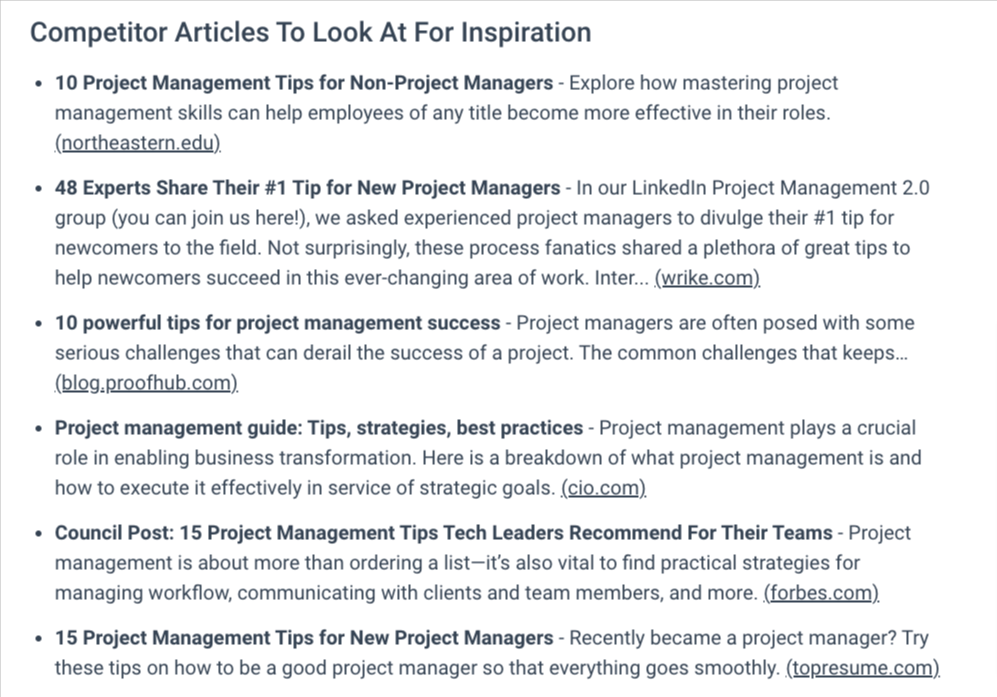How To Hire Your First Freelancer As A Solo Marketer
What do you do when you want to work with a freelancer, but you kinda need help with everything?
I’ve worked with several clients who have been in this boat. Wanting help with everything while not being able to communicate your needs to a freelancer can feel frustrating.
Today, I will walk you through a step-by-step process you can use to go from overwhelmed marketer to a master delegator.
1) Organize Your Thoughts
Before you ever think about connecting with a freelancer, you need to do some internal thought work. Organizing your thoughts will enable you to communicate clearly and effectively with any freelancer that you might work with.
In addition, the time you spend on thought work will help you:
Feel more confident
Pick freelancers that can genuinely help you meet your marketing goals
Build a better relationship with your freelancer from the start
Who doesn’t want those outcomes for their first freelance relationship?
What content do you currently work on?
First, you need to list everything you currently work on.
Be as specific as possible.
For example, don’t say: “I write content.” If you produce articles for your company’s website, you do more than put words on a page. You are:
Researching content ideas
Doing keyword research
Conducting general topic research
Creating outlines
Writing content
Editing content
Selecting or creating images that enhance the post
Getting the post organized in your content management system
Posting the content
…and that’s just part of the process. Every item on this list can be broken into several stages, and you can go down this rabbit hole for a while.
It’s essential to have an exhaustive list because each task could be delegated to a freelancer. You can’t delegate tasks if you don’t make a distinction about the tasks’ existence.
What tasks do you want to work on in the next 3-6 months?
If you are like many marketers, you probably have a few ideas you want to include in your marketing efforts in the next few months. Unfortunately, it can be challenging to find time for those new activities like producing research reports, starting a podcast, or creating video testimonials.
Your to-do list is long, but there are ways to make room for adding more to your plate if you outsource certain parts of your work.
What tasks do you love doing?
One of the most important lessons I learned about outsourcing when I was in-house is to hold on to tasks you love as much as you can. While freelancers can help you scale, you can’t work on high-level tasks every day (especially if they don’t make you happy.)
It’s all about striking a balance between what you love and what you need to do to move your company’s marketing forward.
What tasks do you want to do less of?
These are the tasks that are just so-so. You don’t hate them, but you could probably do less of that task so you can focus on higher-level stuff. You must figure out how much of this task you wouldn’t mind doing and delegate the rest.
What tasks do you hate?
Last, you need to define the tasks you hate. These are the tasks you dread the most every time you have to do them. What do you wish someone else had to tackle? What tasks take more time for you to do than it’s worth? For example, some people delegate budgeting because they hate doing it, and it takes a long time. Delegating budgeting to a personal finance expert might cost money, but it can save you hours of dread/procrastination and even more time working on the task.
Create a task delegation chart
Once you understand all the tasks under the sun, it’s time to put these tasks on a delegation chart.
Tasks you want to keep doing for the foreseeable future. Write down all the tasks you love/like and want to keep working on for now.
Tasks you want to delegate internally to other colleagues. If you have colleagues who can help you with some of your tasks, write out what you want to delegate internally. For example, you could delegate some of your blog post ideas to your company’s founder or CEO.
Tasks you want to delegate externally to a freelancer. Lastly, create a wishlist of all the tasks you would eventually like to delegate externally to a freelancer. I will help you prioritize and figure out what you want to delegate first in the following steps.
2) Find Freelancers Who Fit Your Needs
Congratulations! Thanks to all the work you just did with my task delegation worksheet, you’ve done half the work of finding a great freelancer. Who knew it was that simple? 💁🏽♀️
Here’s the truth, many solo marketers approach freelancers with every idea under the sun. But, if you take the time to realize what you want first, everything else will be simple.
Figure Out What You Want To Delegate First
Before finding a freelancer, focus on an area or areas you want to delegate first. Look at the blue column on your delegation brainstorm worksheet for the list of tasks you want to delegate to freelancers.
After that, think about the tasks that are currently on your plate. Which tasks make sense to delegate based on what you are currently working on? Start there.
Search For Freelancers Who Have Those Exact Skills
Once you have the task you want to delegate, it’s time to find a freelancer who can do that task. Are you stuck on where to find a freelancer? Here are a few places:
Ask a colleague who they’ve worked with.
Google “{task} freelancer” to find a freelancer who can do what you need.
Use a site like Upwork to find a freelancer.
Search for freelancers in a Slack community.
Look for a freelancer by searching on LinkedIn.
Before you know it, you’ll have lots of freelancers to work with.
3) Share The Project You Have In Mind And Get Feedback From Your Freelancer
Once you have a freelancer or two in mind, reach out to them to set up a call.
On the call with the freelancer, run through the exact thing you need help with.
This is not the time to throw spaghetti on the wall to see what sticks.
Later, you might find out that a freelancer can work on other tasks, but you need to be focused when starting a freelance relationship. Otherwise, you’ll be confused, and so will they.
Related Reading: 10 Tools To Help You Collaborate With Freelancers
4) Create A Project Brief And Delegate The Work
Once a freelancer has agreed to work with you, it’s time to create a project brief and delegate the work. Project briefs determine what the end project will be. The more detailed your brief, the better the result will be.
Related Reading: What Is A Content Style Guide And What Should You Include In It?
Content Project Briefs
My favorite tool for creating project briefs is Frase (although there are tons on the market like Clearscope, Surfer, and Topic.)
Here’s a look at a project brief I pulled together for a freelancer when I outsourced a blog for one of my websites:
Once you have a brief in Frase, you can easily download the brief as a PDF or HTML. You can also share a link to a read-only Frase doc or open up access so your writer can use Frase tools when crafting the blog post.
Other Project Briefs
If you aren’t providing a project brief for a piece of content, think about everything a person might need to complete the project. Here are some examples of what you might provide in different project briefs:
Graphic design
Details about your brand and what clients you serve
Inspiration from other projects you like
The finished project you are looking for with dimensions (a completed logo, a rebrand, social media templates, etc.)
Existing branding and what you love/don’t love about it.
Budget for the finished project
Podcasting editing
Podcast title and details
Audio file to be edited
Similar podcast shows you or your audience enjoys
Old episodes of the show with great editing
Budget for the finished audio editing
eBook creation
A summary of the eBook and the chapters
Design direction (if they’ll be designing the eBook)
eBooks from other brands that you enjoy
Details about your brand and the content style your audience enjoys
Budget for the finished eBook
Email creation
A list of the email(s) you want to have created and the associated word count
Past emails your audience has reacted to positively
Emails that you enjoy
Design direction for email headers, links, etc.
Budget for the finished emails
Social media creation
General guidance on the types of social content you want created
Brand guidelines (if they will be making or finding imagery)
Social content and accounts that you enjoy
Past content that your audience has interacted with most
Budget for the finished social media posts
Conclusion: It’s Okay To Be Overwhelmed, But You Can Still Get Content Help
Working with your first freelancer can feel scary, but it doesn’t have to be. There are tons of freelancers (like me) who want to see your business succeed. By understanding your needs as a marketer, sharing your ideas with a freelancer, and creating a helpful brief, you can make your first freelance relationship successful. It’s time to stop drowning under the weight of being a team of one.
I hope you found this article helpful in your marketing journey. I recently revamped my packages, so check out my hire me page if you are looking for SEO content, SEO content with quote sourcing, or SME interview-based content.





